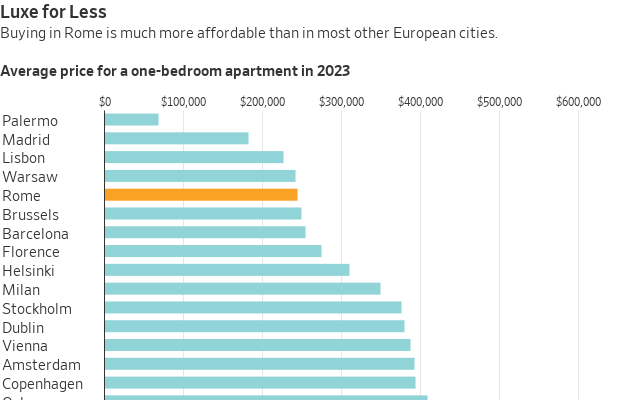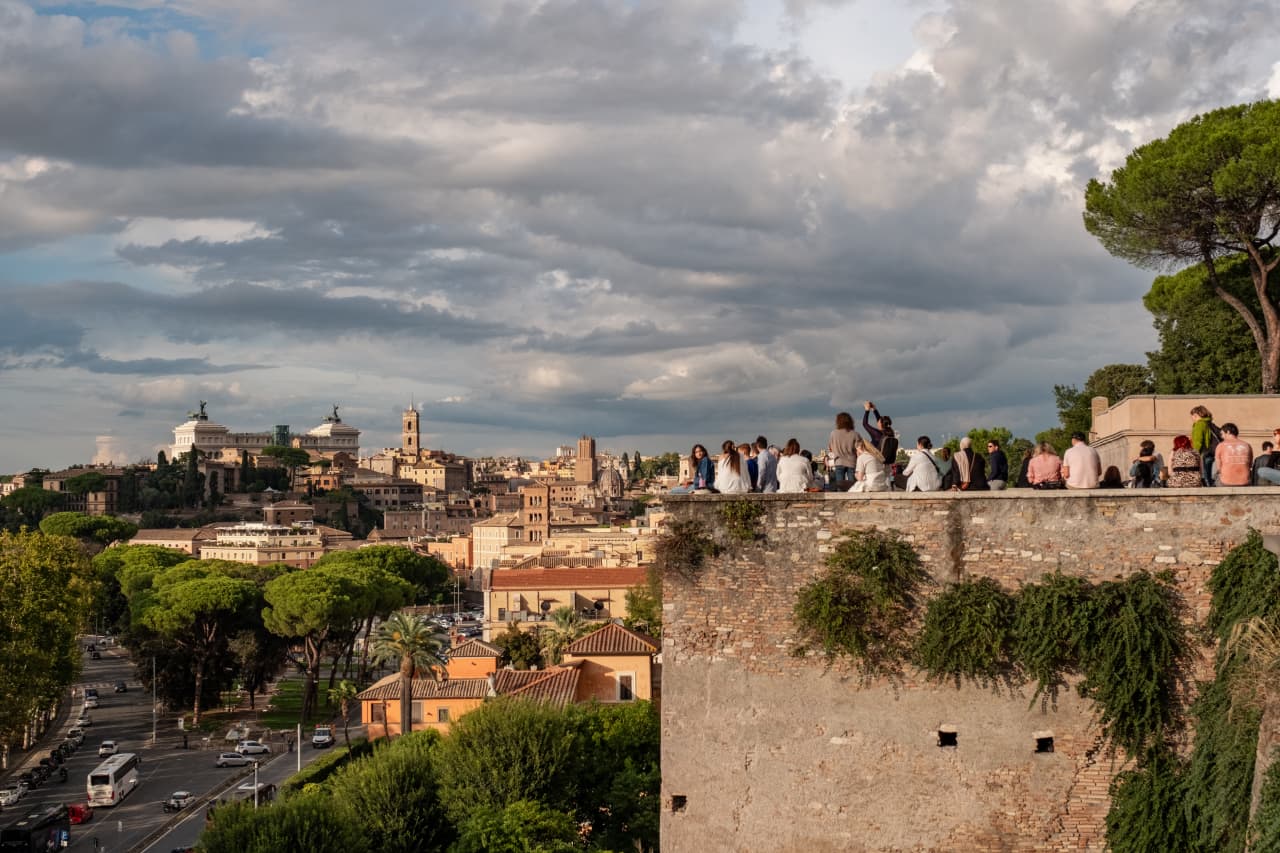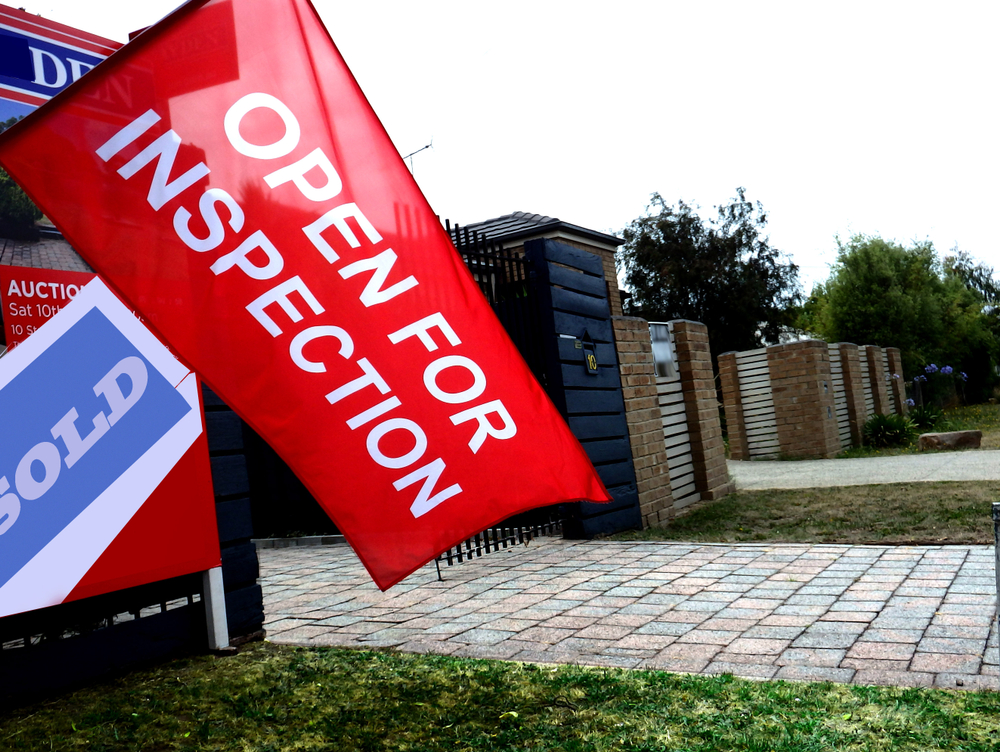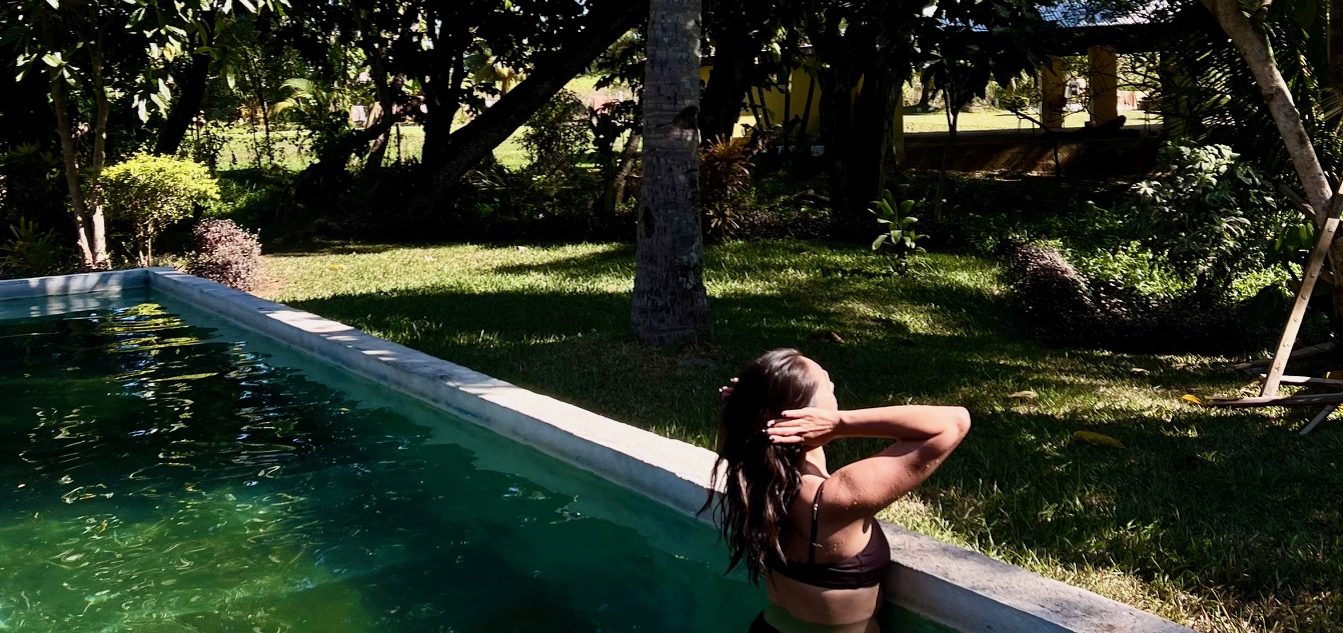Even in Its Priciest Neighbourhoods, Buying in Rome Remains a Bargain
Compared with other luxury housing markets in Europe, buyers get more bang for their buck in Italy’s capital
Gianluca and Selene Santilli have all of Rome at their feet.
Their four-storey penthouse apartment in an early 20th-century villa sits atop a hill in the Italian capital’s Parioli district. With 360-degree views from sitting rooms and outdoor areas, the property provides glimpses of the dome of St. Peter’s Basilica, residential Parioli’s towering pine trees and the winding course of the Tiber River.
The 4,010-square-foot home has free-standing pavilion-like spaces that suggest an urban compound more than an individual apartment. Now, after nearly two decades in the custom-designed space, the couple have listed the four-bedroom unit with Italy/Sotheby’s International Realty. It has an asking price of $6.1 million.
A similar level of luxury in Milan, Italy’s financial and fashion capital, would cost a lot more, says Gianluca, a 67-year-old attorney. “Rome is cheap,” he says, of both the homes for sale and for rent.
Gianluca and Selene, a 64-year-old office manager, priced their home at just under $1,500 a square foot. In Milan, by comparison, a smaller three-bedroom, 2,750-square-foot unit in a decade-old high-rise, with lavish views and similarly upscale fittings, is listed for $6.445 million, or about $2,350 a square foot.
Roman-style luxury was once associated with the gargantuan villas of ancient emperors and the frescoed palaces of Baroque-era princes, but these days it conjures up another phrase: a bargain.
Affordable Luxury
Rome’s average home prices, as of August, were about $350 a square foot—less than Italy’s Florence and Bologna, and around a third less than Milan, according to Immobiliare.it, a real-estate website.
Prices in Rome peaked in 2007, and the city has been slow to encourage new development and investment, says Antonio Martino, the Milan-based real-estate advisory leader for PwC Italy. In Milan, on the other hand, an increase in supply has been outpaced by a greater increase in demand, he says.
A one-bedroom apartment in Rome is far more affordable than the average for major European cities, coming in below Barcelona, Amsterdam and Vienna, according to an affordability index compiled by Savills, the international real-estate company, which analyzed apartments outside of the historic city centres.
An average-earning Roman might need only four years’ salary to buy the apartment, while a Parisian would likely need more than twice that, according to Savills.

Rome’s luxury sector is showing new signs of life, outpacing the rest of the market, says Danilo Orlando, managing director of Savills Residential Italy. Comparing 2023 sales of homes over $1.1 million with prepandemic 2019 levels, he says, prices in Rome have increased 4% while the number of luxury-level transactions has risen 3.6%. Overall real-estate transactions were up 3% in the second quarter of this year, compared with a year earlier, says PwC’s Martino.
Orlando says that residential luxury sales in Rome are traditionally concentrated in three nearby areas that are the city’s most expensive: The Centro Storico, or the historic center, is where centuries-old palaces are often broken up into lavish multi-bedroom apartments. Parioli is a hilly district known for its Midcentury Modern flare. And a short walk away is Trieste, which has clusters of early 20th-century apartment buildings that vie in splendour with their Baroque counterparts down in the centre.
Centro Storico and Trieste
Centro Storico is by far the most expensive, says Orlando, with average prices in the premium sector reaching $1,493 a square foot in 2023. Luxury units in Parioli average about $950 a square foot, while those in Trieste are about $900 a square foot.
Tourists may flock to Centro Storico’s celebrated sites, like the Trevi Fountain, or make their way through the Villa Borghese, a massive landscaped garden that serves as a green space for both Parioli and Trieste. But they are likely to miss the three districts’ prime residential areas, which can seem discreet, if not outright hidden.
Centro Storico’s Via Giulia, running just east of the Tiber, and Via Margutta, tucked under Piazza del Popolo, are hard-to-find streets if you’re not looking for them. Via Giulia was once the address of choice for Roman nobles, and it can still lay claim to being one of the city’s most prestigious streets. A two-bedroom Via Giulia triplex, located in a building dating back to the 16th century and outfitted with vintage coffered ceilings, is listed with Italy/Sotheby’s, with an asking price of $2 million.
The centrepiece of Trieste is the Coppedè quarter, a neighbourhood of towering 1910s and ’20s apartment buildings, decorated with Moorish arches and ghoulish gargoyles, and built around a storybook-like frog fountain. Conceived by an eccentric Florentine-born architect named Gino Coppedè, the quarter combines Art Nouveau elements with a range of historical styles.
Exclusive RE/Christie’s International Real Estate has a well-maintained, four-bedroom Coppedè listing for $3.56 million. Original details in the 3,770-square-foot home include stained-glass windows, mosaic tile floors and painted ceilings.
Parioli and Pinciano
Parioli, with its many steep streets, is a bit more remote, while Trieste is flatter and more urban. For many luxury-minded Romans, a fine compromise is Pinciano, a neighborhood beneath the heart of Parioli that is as rarefied as its hilly neighbour but as accessible as Trieste.
In 2007, Dr. Claudio Giorlandino, a Roman gynaecologist, created a sprawling family home in a Pinciano building that had been commissioned just before World War I, he says, by a member of the House of Savoy, then the Kingdom of Italy’s ruling family. Designed by a noted Venetian-Jewish architect and decorated with marble recovered from a Palladian villa in northeast Italy, the building has a small number of units, with Giorlandino’s 6,200-square-foot apartment taking up a whole floor.
“I love the elegance and the extremely refined, aristocratic atmosphere,” Giorlandino, now 70, says of his neighbourhood, which borders the Villa Borghese.
Now that two of his three children are grown and living on their own, he has listed the home with Exclusive RE/Christie’s for $6.89 million.
Rome’s three most expensive districts can seem like a self-contained world, with residents moving around between them. Giorlandino, who relocated from the Centro Storico to Pinciano, is now thinking about moving back to the historic centre. The Santillis, who moved to Parioli from Trieste, are considering looking for a more compact rental still in Parioli, which they say feels insulated from the Italian capital’s notorious traffic.
“We have the historic centre nearby, but we are not in the chaos of the centre,” says Gianluca Santilli, adding that he considers “the jewels” of his unique penthouse to be the home’s three parking spaces.
Vatican views
American buyers, traditionally drawn to the Centro Storico, are also open to Parioli and to the Aventine Hill, a very steep, purely residential area on the edge of the historic centre, says Diletta Giorgolo, head of residential at Italy/Sotheby’s.
Known for its jaw-dropping views of the Vatican and for its sedate, almost suburban quality, the Aventino, as Italians call it, may be Rome’s most elusive address. Premium listings rarely come up for sale.
Lionard Luxury Real Estate currently has a ¼-acre Aventino compound, with an early 20th-century 10,800-square-foot villa, listed for $22.2 million.
Mother-daughter apartments
A new Centro Storico development proved too good to pass up for Delphine Surel-Chang, a U.S.-born student studying business in Rome, and her French mother, former actress and investor Francoise Surel, who will also relocate.
The two are putting the finishing touches on their new homes in the Palazzo Raggi, where 21st-century details are being installed in a renovated 18th-century palazzo situated between the Trevi Fountain, Piazza Navona and the Pantheon. This summer, Surel purchased a 1,460-square-foot, two-bedroom apartment for herself, and Surel-Chang says her parents helped her buy a 645-square-feet one-bedroom. The units cost $1.88 million and about $944,000, respectively. They are set to move in later this year.
Surel-Chang, 20, says she loves how the project’s contemporary elements—which she and her mother, 60, are augmenting with kitchens and bathrooms from Italy’s sleek Boffi brand—are housed in a classical setting. And she appreciates amenities like a concierge and home automation, allowing residents to control temperature, lighting and appliances via app.
She was able to customise her unit’s interiors, she says, by drawing inspiration from her two favorite local hotels, the Bulgari Hotel Roma and Six Senses Rome. She plans to furnish the unit, where she says they will stay for at least three years, with Italian Midcentury Modern pieces.
The duo bought the apartments—which are a five-minute walk from Via Condotti, Rome’s premier shopping street—for between $1,200 and $1,500 a square foot, using Italy/Sotheby’s, which also helped develop the project.
The apartments can seem like a bargain compared with similarly situated units in other major cities. For instance, a two-bedroom, 2,025-square-foot apartment in London’s Mayfair district—a five-minute walk from Bond Street, Via Condotti’s U.K. shopping district equivalent—is asking nearly $10,000 a square foot.
Affordability played a part in their choice of the Eternal City, says Surel-Chang. They considered relocating to Paris, she says, but soon realised that “for the price of an apartment in Paris, we can afford two in Rome.”
 Copyright 2020, Dow Jones & Company, Inc. All Rights Reserved Worldwide. LEARN MORE
Copyright 2020, Dow Jones & Company, Inc. All Rights Reserved Worldwide. LEARN MORE
A divide has opened in the tech job market between those with artificial-intelligence skills and everyone else.
A 30-metre masterpiece unveiled in Monaco brings Lamborghini’s supercar drama to the high seas, powered by 7,600 horsepower and unmistakable Italian design.
Buyer demand, seller confidence and the First Home Guarantee Scheme are setting up a frantic spring, with activity likely to run through Christmas.
The spring property market is shaping up as the most active in recent memory, according to property experts Two Red Shoes.
Mortgage brokers Rebecca Jarrett-Dalton and Brett Sutton point to a potent mix of pent-up buyer demand, robust seller confidence and the First Home Guarantee Scheme as catalysts for a sustained run.
“We’re seeing an unprecedented level of activity, with high auction numbers already a clear indicator of the market’s trajectory,” said Sutton. “Last week, Sydney saw its second-highest number of auctions for the year. This kind of volume, even before the new First Home Guarantee Scheme (FHGS) changes take effect, signals a powerful market run.”
Rebecca Jarrett-Dalton added a note of caution. “While inquiries are at an all-time high, the big question is whether we will have enough stock to meet this demand. The market is incredibly hot, and this could lead to a highly competitive environment for buyers, with many homes selling for hundreds of thousands above their reserve.”
“With listings not keeping pace with buyer demand, buyers are needing to compromise faster and bid harder.”
Two Red Shoes identifies several spring trends. The First Home Guarantee Scheme is expected to unlock a wave of first-time buyers by enabling eligible purchasers to enter with deposits as low as 5 per cent. The firm notes this supports entry and reduces rent leakage, but it is a demand-side fix that risks pushing prices higher around the relevant caps.
Buyer behaviour is shifting toward flexibility. With competition intense, purchasers are prioritising what they can afford over ideal suburb or land size. Two Red Shoes expects the common first-home target price to rise to between $1 and $1.2 million over the next six months.
Affordable corridors are drawing attention. The team highlights Hawkesbury, Claremont Meadows and growth areas such as Austral, with Glenbrook in the Lower Blue Mountains posting standout results. Preliminary Sydney auction clearance rates are holding above 70 per cent despite increased listings, underscoring the depth of demand.
The heat is not without friction. Reports of gazumping have risen, including instances where contract statements were withheld while agents continued to receive offers, reflecting the pressure on buyers in fast-moving campaigns.
Rates are steady, yet some banks are quietly trimming variable and fixed products. Many borrowers are maintaining higher repayments to accelerate principal reduction. “We’re also seeing a strong trend in rent-vesting, where owner-occupiers are investing in a property with the eventual goal of moving into it,” said Jarrett-Dalton.
“This is a smart strategy for safeguarding one’s future in this competitive market, where all signs point to an exceptionally busy and action-packed season.”
Two Red Shoes expects momentum to carry through the holiday period and into the new year, with competition remaining elevated while stock lags demand.
A cluster of century-old warehouses beneath the Harbour Bridge has been transformed into a modern workplace hub, now home to more than 100 businesses.
From mud baths to herbal massages, Fiji’s heat rituals turned one winter escape into a soul-deep reset.
























